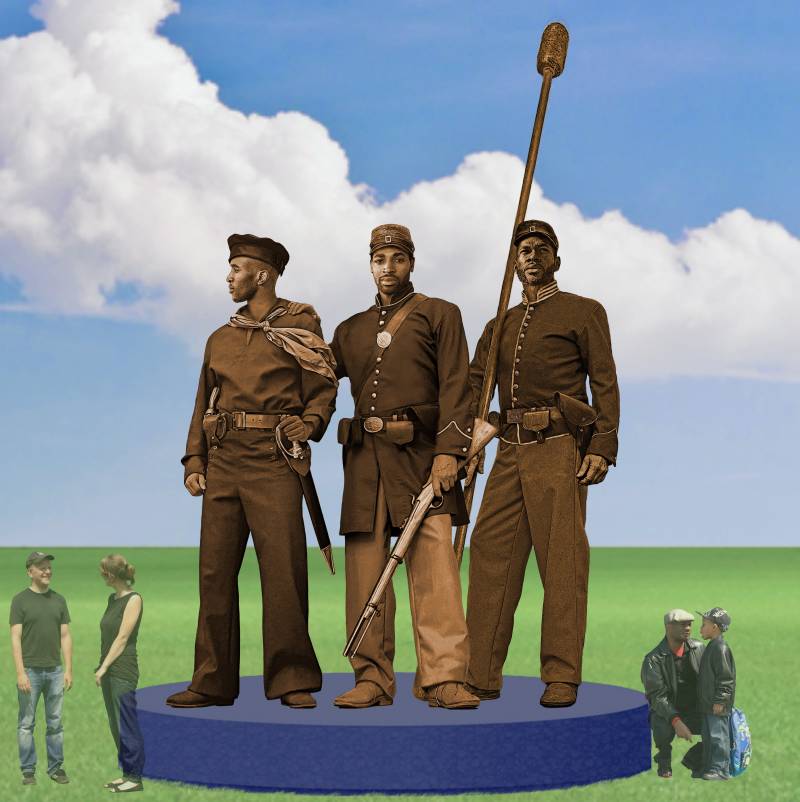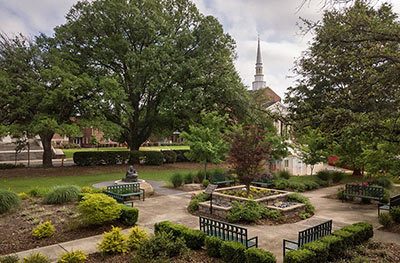Natchez Monument Committee Selects MC Alum to Create Stunning U.S. Colored Troops Memorial

Sculptor Thomas Jay Warren has spent the balance of his career casting striking images of historical figures that captivate the imagination and inspire generations to learn about their remarkable accomplishments.
The Mississippi College alum’s sculptures are more than three-dimensional works of art: they are bronze paeans to extraordinary individuals who helped shape our culture and the American way of life.
His larger-than-life creations stand sentinel across the national landscape. “The Mourning Soldier,” a 12-foot solitary figure peering down at the dog tags of fallen comrades, part of a Korean War memorial in Atlantic City, New Jersey, may be his favorite piece. His 14-foot statue of Dr. Martin Luther King, Jr. holding the Civil Rights Act of 1964 and the Voting Rights Act of 1965, located in Newark, New Jersey, is the largest bronze statue of the Civil Rights leader in the world.
The Medgar Evers Memorial in Jackson; the Sojourner Truth Memorial in Northampton, Massachusetts; the Rosa Parks Memorial in Essex County, New Jersey; the Emancipation and Freedom Monument in Richmond, Virginia; the “Brothers in Arms” Vietnam War Memorial in Oklahoma City; the Battle of Pines Bridge Monument in Yorktown Heights, New York; in all, Warren has created 53 public works of art displayed in 20 U.S. states and Canada.
“I was talking to a gentleman about possibly doing a Marine Corps piece at Quantico,” said Warren, a 1980 magna cum laude graduate of MC. “He’s a hard-core Marine and had served in Vietnam. He told me he had seen the New Jersey Korean War Memorial, and it had brought him to tears.
“I think that’s probably my best work.”
The Rogue River, Oregon, resident will soon embark on a project to commemorate lesser-known yet remarkable heroes of the American Civil War. A “U.S. Colored Troops” monument will include a trio of 12-foot bronze statues crafted by Warren to recognize the three military areas formerly enslaved men served near the end of the nation’s deadliest conflict: the U.S. Navy, the U.S. Colored Troops Infantry; and the U.S. Colored Troops Heavy Artillery.
The monument will bear the names of the African-American men who served with six regiments at Fort McPherson just north of downtown Natchez. It will stand beside the roiling waters of the Mississippi River on the northern end of the sun-drenched bluff at the corner of Madison and Broadway Streets. The list of names will include those who served in the Navy and were born in Natchez.
The six regiments in which the men served include the 6th U.S. Colored Heavy Artillery, the 58th U.S. Colored Infantry, the 70th U.S. Colored Infantry, the 71st U.S. Colored Infantry, the 63rd U.S. Colored Infantry, and the 64th U.S. Colored Infantry. In addition to honoring the U.S. Colored Troops, the project will recognize their descendants, many of whom still live in the Natchez area.
“There’s so much incredible history around Fort McPherson and the U.S. Colored Troops in the war,” Warren said. “When they first arrived, the all-Black 58th Infantry Division was given the job of tearing down the Forks of the Road, one of the biggest slave markets in the country.
“They tore the whole place down in one day and used the wood to build Fort McPherson.”
In August 2022, the Natchez U.S. Colored Troops Monument Committee unanimously selected Warren through a nationally competitive process to create a conceptual and schematic design for the monument. Committee members envisioned the memorial as a tribute to the individual African-American Army and Navy enlistees who “deserve their history to be known, respected, and honored.” The monument is intended to be an engaging place of inspiration, retrospection, and connection.
Lance Harris, co-chair of the group’s Monument Design Subcommittee, said Warren was an excellent choice given his previous work and experience.
“His submittal was extensive and impressive,” Harris said. ”While Mr. Warren was chosen on the strength of his work and previous experience, it is an added feature that he is from Mississippi and has a deep connection to the state and an understanding of its past.”
Born in Vicksburg and raised in the Mississippi Delta, Warren grew up along the Blues Highway and became valedictorian of Rolling Fork High School. Throughout his teens, Warren’s family frequently visited the Vicksburg National Military Park, where he admired the artistry of the statues.
“The thought never crossed my mind even to try to do something like that until I got to MC,” he said.
Warren started as a painter, but Samuel Gore, the internationally celebrated Christian artist dubbed the “Founding Father of the Mississippi College Art Department,” urged the promising student to try sculpting.
He never picked up a paintbrush again.
“All I’ve done is sculpt, and it was on Dr. Gore’s encouragement,” Warren said. “He saw talent in me, and he encouraged it. I was in a great class of artists – I went to class with Wyatt Waters, Steve Glaze, and Albert Smathers – it was a golden age for art at MC.
“I love the three-dimensional form of sculpture, the infinite number of viewpoints. You can walk around a piece all day, see it from different angles, and see it differently each time.”
Warren made his first pilgrimage to Natchez – and his last, until the U.S. Colored Troops Monument project – while at MC.
“I was hired while I was in college to do a portrait of a young lady who lived in Natchez,” he said. “I drove down there, and she sat for me one day. I sculpted her portrait – it was my first commission – and even though I enjoyed the trip and Natchez is a beautiful city, I’ve never been back.”
After graduating from MC, Warren became an apprentice at the Johnson Atelier Technical Institute of Sculpture in Hamilton, New Jersey, where he studied under renowned sculptor Andrzej Pitynski.
“My aptitude for sculpting the portrait, capturing likeness and character, and encompassing the emotions and memories of historical events exemplify my body of work,” Warren says.
In 1992, he received the National Sculpture Society’s Young Sculptors Award; in 1997, he was elected as a professional member of the society; and in 2012, he became an elected member of the Portrait Sculptors Society of the Americas.
His work is not limited to U.S. history. The First and Fourth Stations of the Cross he created in Gretna, Nebraska, is part of the largest sculptural realization of Christ’s passion and death on the cross. Produced by a team of 10 artists at a retreat called the Cloisters on the Platte, the work is viewed by thousands of visitors each year.
Harris said the first phase of the Natchez U.S. Colored Troops monument creation will be completed soon, pending the committee’s approval.
“This phase is for the conceptual and schematic design and includes an extensive site plan that incorporates landscaping and programmatic planning,” he said. “Mr. Warren, as the principal for this work, has included the sculptural element to integrate into the plan cohesively.”
Warren’s plans call for the expressions on the faces of the three bronze figures to be inspired by daguerreotypes of U.S. Colored Troops.
“I want people to see young men who were brave and willing to fight for their freedom and honor,” he said. “In the way I plan to have the figures posed – the sailor looking off toward the river, the heavy artilleryman looking to the right, the soldier in the center looking directly at you – I want to show the brotherhood among the different units.
“Using new technology, the monument will link to the U.S. Colored Troops Monument in Washington, D.C., and QR codes will let people dive into the history of these soldiers and connect to other historical places in Natchez.”
In keeping with his impressive catalog of work, the monument will educate as much as it illuminates, and inspire as much as it emotes.
“It’s going to be a big piece. That’s what these men deserve,” he said.
He teamed with another Mississippian, landscape designer Brantley Snipes of Greenwood, who designed the perfect setting for the monument.
“It will be located in a big, open space, the same field where the soldiers actually trained for the Civil War,” Warren said. “It’s going to be a beautiful space.”
The sculpture will take several months to prepare, but Warren has already done his homework. He purchased authentic uniforms for his models to wear, and he spent countless hours in the studio posing them until he could determine the right composition.
He tells students that successful sculpting is equal parts talent and hard work.
“You have to have the drive to do it,” he said. “Don’t expect your first pieces to be masterpieces. Make them, throw them out, and keep going.
“If you have the talent and you have the drive, you can make it work.”
For more information about Warren’s work, visit his website at warrensculpture.com.
Sign-up For Our Newsletter
Get the latest news about Mississippi College delivered right to your inbox by subscribing to the Along College Street e-newsletter.


